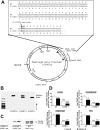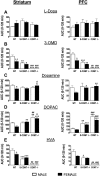Importance of membrane-bound catechol-O-methyltransferase in L-DOPA metabolism: a pharmacokinetic study in two types of Comt gene modified mice
- PMID: 19930170
- PMCID: PMC2807650
- DOI: 10.1111/j.1476-5381.2009.00494.x
Importance of membrane-bound catechol-O-methyltransferase in L-DOPA metabolism: a pharmacokinetic study in two types of Comt gene modified mice
Abstract
Background and purpose: Catechol-O-methyltransferase (COMT) metabolizes compounds containing catechol structures and has two forms: soluble (S-COMT) and membrane-bound (MB-COMT). Here we report the generation of a mouse line that expresses MB-COMT but not S-COMT. We compared the effects of deleting S-COMT only or both COMT forms on the pharmacokinetics of oral L-DOPA.
Experimental approach: L-DOPA (10 mg kg(-1)) and carbidopa (30 mg kg(-1)) were given to mice by gastric tube, and samples were taken at various times. HPLC was used to measure L-DOPA in plasma and tissue samples, and dopamine and its metabolites in brain. Immunohistochemistry and Western blotting were used to characterize the distribution of COMT protein isoforms.
Key results: Lack of S-COMT did not affect the levels of L-DOPA in plasma or peripheral tissues, whereas in the full COMT-knock-out mice, these levels were increased. The levels of 3-O-methyldopa were significantly decreased in the S-COMT-deficient mice. In the brain, L-DOPA levels were not significantly increased, and dopamine was increased only in females. The total COMT activity in the S-COMT-deficient mice was 22-47% of that in the wild-type mice. In peripheral tissues, female mice had lower COMT activity than the males.
Conclusions and implications: In S-COMT-deficient mice, MB-COMT in the liver and the duodenum is able to O-methylate about one-half of exogenous L-DOPA. Sexual dimorphism and activity of the two COMT isoforms seems to be tissue specific and more prominent in peripheral tissues than in the brain.
Figures





Similar articles
-
Delayed O-methylation of l-DOPA in MB-COMT-deficient mice after oral administration of l-DOPA and carbidopa.Xenobiotica. 2018 Apr;48(4):325-331. doi: 10.1080/00498254.2017.1315781. Epub 2017 Apr 21. Xenobiotica. 2018. PMID: 28375049
-
Pharmacokinetic-pharmacodynamic interaction between nebicapone and controlled-release levodopa/benserazide: a single-center, Phase I, double-blind, randomized, placebo-controlled, four-way crossover study in healthy subjects.Clin Ther. 2009 Oct;31(10):2258-71. doi: 10.1016/j.clinthera.2009.10.019. Clin Ther. 2009. PMID: 19922897 Clinical Trial.
-
Generation of membrane-bound catechol-O-methyl transferase deficient mice with disctinct sex dependent behavioral phenotype.J Physiol Pharmacol. 2016 Dec;67(6):827-842. J Physiol Pharmacol. 2016. PMID: 28195063
-
Effects of catechol-O-methyltransferase (COMT) inhibition on the pharmacokinetics of L-DOPA.Adv Neurol. 1996;69:493-6. Adv Neurol. 1996. PMID: 8615170 Review. No abstract available.
-
Clinical pharmacology, therapeutic use and potential of COMT inhibitors in Parkinson's disease.Drugs. 2000 Jun;59(6):1233-50. doi: 10.2165/00003495-200059060-00004. Drugs. 2000. PMID: 10882160 Review.
Cited by
-
COMT gene locus: new functional variants.Pain. 2015 Oct;156(10):2072-2083. doi: 10.1097/j.pain.0000000000000273. Pain. 2015. PMID: 26207649 Free PMC article.
-
Characterization of non-nitrocatechol pan and isoform specific catechol-O-methyltransferase inhibitors and substrates.ACS Chem Neurosci. 2012 Feb 15;3(2):129-40. doi: 10.1021/cn200109w. Epub 2011 Nov 14. ACS Chem Neurosci. 2012. PMID: 22860182 Free PMC article.
-
Effect of S-COMT deficiency on behavior and extracellular brain dopamine concentrations in mice.Psychopharmacology (Berl). 2010 Sep;211(4):389-401. doi: 10.1007/s00213-010-1944-2. Epub 2010 Jul 9. Psychopharmacology (Berl). 2010. PMID: 20617305
-
The Design and Evaluation of an l-Dopa-Lazabemide Prodrug for the Treatment of Parkinson's Disease.Molecules. 2017 Nov 27;22(12):2076. doi: 10.3390/molecules22122076. Molecules. 2017. PMID: 29186917 Free PMC article.
-
Drug Development for Alzheimer's and Parkinson's Disease: Where Do We Go Now?Pharmaceutics. 2024 May 24;16(6):708. doi: 10.3390/pharmaceutics16060708. Pharmaceutics. 2024. PMID: 38931832 Free PMC article. Review.
References
-
- Airavaara M, Mijatovic J, Vihavainen T, Piepponen TP, Saarma M, Ahtee L. In heterozygous GDNF knockout mice the response of striatal dopaminergic system to acute morphine is altered. Synapse. 2006;59:321–329. - PubMed
-
- Albertazzi P, Purdie PW. The life and times of the estrogen receptors: an interim report. Climacteric. 2001;4:194–202. - PubMed
-
- De Santi C, Giulianotti PC, Pietrabissa A, Mosca F, Pasifici GM. Catechol-O-methyltransferase: variation in enzyme activity and inhibition by entacapone and tolcapone. Eur J Clin Pharmacol. 1998;54:215–219. - PubMed
Publication types
MeSH terms
Substances
LinkOut - more resources
Full Text Sources
Molecular Biology Databases
Miscellaneous

